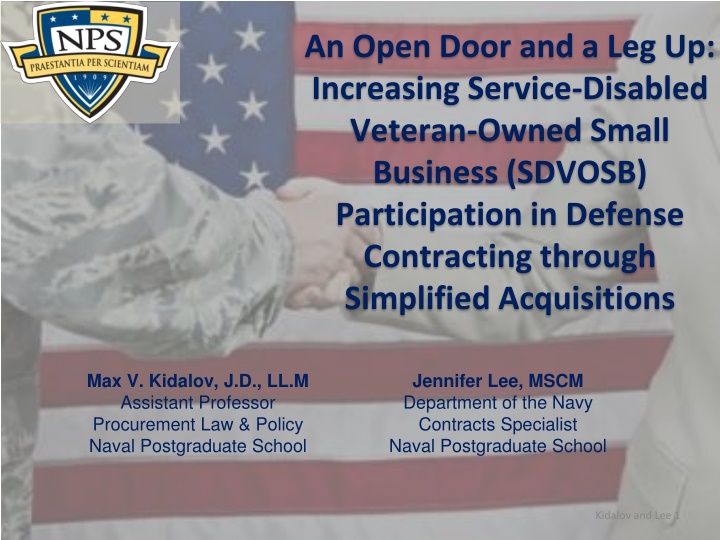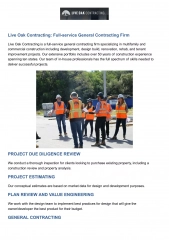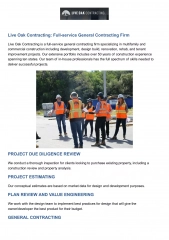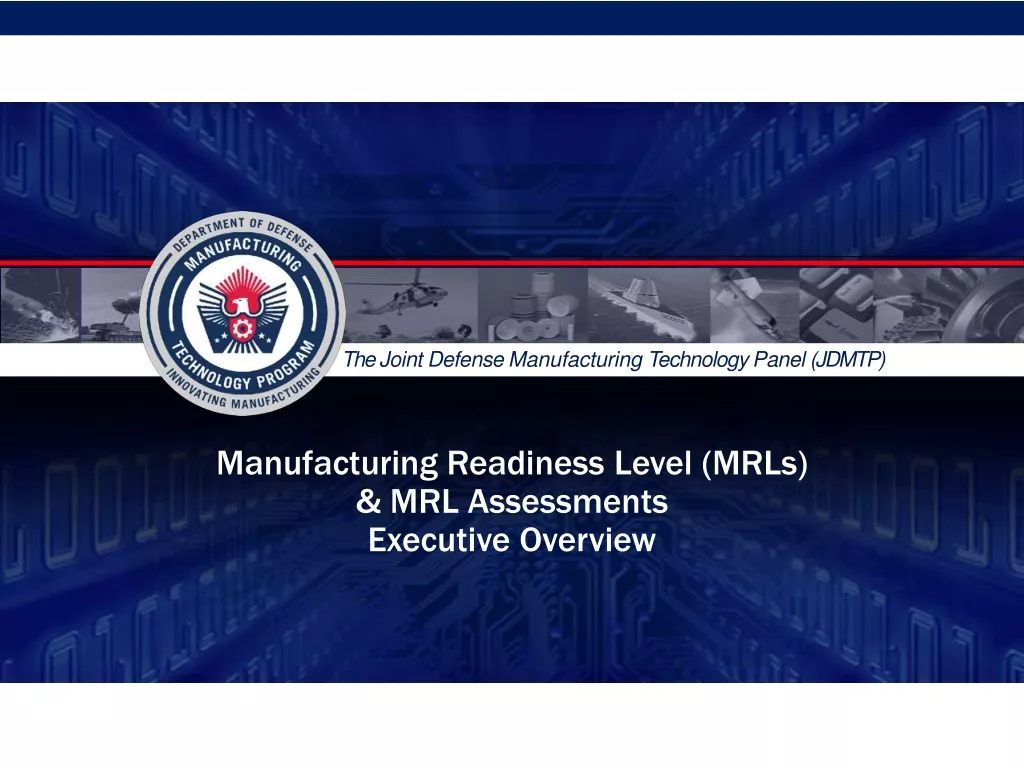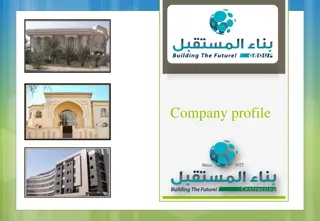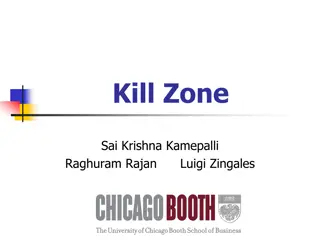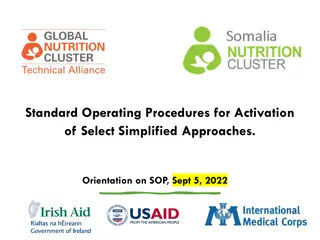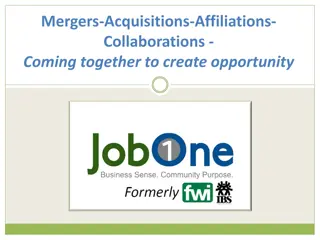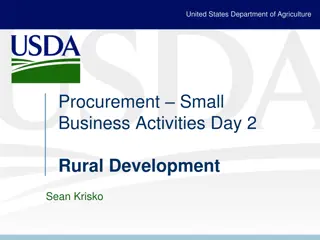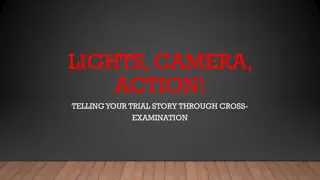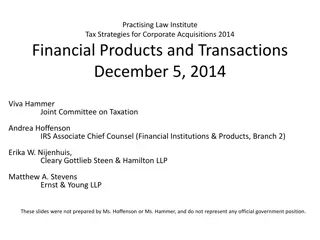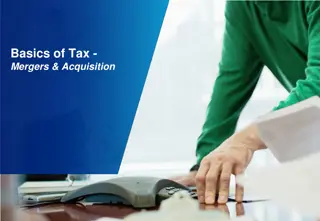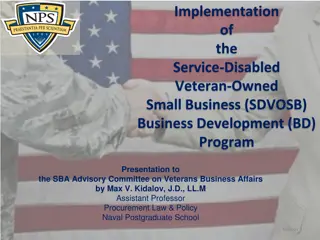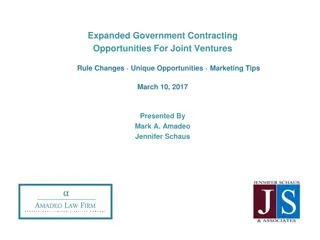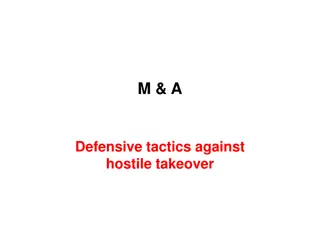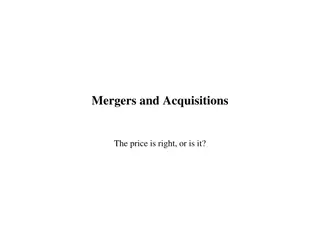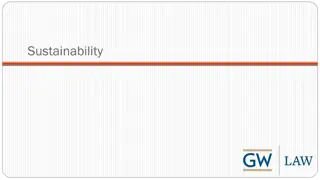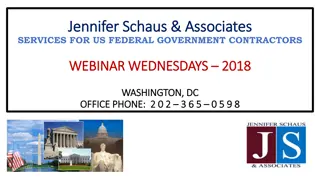Increasing SDVOSB Participation in Defense Contracting through Simplified Acquisitions
Research identifies a paradox in achieving SDVOSB goals despite predicted malfunction factors. It explores questions on program understanding, Contracting Officer discretion, and the impact of Simplified Acquisitions. Methodology involves reviewing academic assessments and applying a performance model to analyze SDVOSB program design.
Download Presentation

Please find below an Image/Link to download the presentation.
The content on the website is provided AS IS for your information and personal use only. It may not be sold, licensed, or shared on other websites without obtaining consent from the author.If you encounter any issues during the download, it is possible that the publisher has removed the file from their server.
You are allowed to download the files provided on this website for personal or commercial use, subject to the condition that they are used lawfully. All files are the property of their respective owners.
The content on the website is provided AS IS for your information and personal use only. It may not be sold, licensed, or shared on other websites without obtaining consent from the author.
E N D
Presentation Transcript
An Open Door and a Leg Up: Increasing Service-Disabled Veteran-Owned Small Business (SDVOSB) Participation in Defense Contracting through Simplified Acquisitions Max V. Kidalov, J.D., LL.M Assistant Professor Procurement Law & Policy Naval Postgraduate School Jennifer Lee, MSCM Department of the Navy Contracts Specialist Naval Postgraduate School Kidalov and Lee 1
Note on the Usual Disclaimers Study opinions/findings/conclusions: Nothing in this study shall be construed as an expression of official views of the Department of Defense or the Department of the Navy, or as comments on the merits of any pending litigation. Data quality: Sources: Federal Procurement Data System-Next Generation, SAM, Census, DOL, VA Other disclaimers/caveats: In text of the study: http://calhoun.nps.edu/handle/10945/47473 2
Research Problem Identified Research Problem: Paradox between DOD s FY14 real goal achievement success (spending in excess of 3 percent prime contracting goals), and consistent academic predictions of SDVOSB Program malfunction and failure Academic Assessments: Schooner (2004), Sherman (2006), Korsak (2008), Cox & Moore (2013), McGann (2014) Malfunction factors from academic assessments: Veteran Disillusionment in the SDVOSB Program Veteran and Gov t Buyer Confusion about the nature of SDVOSB Program and its tools Entrenchment of already successful SDVOSB firms 3
Research Questions Research Questions: 1. Can the SDVOSB Program be understood in terms of the generally accepted Cohen-Eimicke contract management performance model (inputs, process, outputs, and outcome) 2. Is individual-level Contracting Officer discretion the right mechanism to support SDVOSB participation in Defense contracting? 3. Can Simplified Acquisitions positively influence SDVOSB Program outcomes? 4
Methodology Review of Prior Academic Assessments Theoretical Foundation of Effective Program Design - applying the Cohen & Eimicke Contract Management Performance Model to Socio-Economic Contracting Understanding the performance taxonomy of SDVOSB Program designs by various decision-makers - Laws, regulations, policies, and adjudicatory precedents FPDS/SAM/VA data analysis for validation of SDVOSB - Current SDVOSB Program performance design taxonomy; examination of Contracting Officer discretion trends; and examination of opportunities for use of Simplified Acquisitions Discussion, Conclusions, Recommendations 5
Contract Management Performance Model Cohen & Eimicke, The Responsible Contract Manager (2008) Inputs Process Outputs Outcome Applied to the SDVOSB Program Inputs Process Outputs Outcome DOD Contracting as a Viable Self- Employment Path for Service-Disabled Veterans at Large Number of Active SDVOSBs receiving contract awards Individual-level DOD Contracting Officer discretion, laws, regulations, orders, precedents, plans Dollars awarded with SDVOSB, bench-marked to the 3% statutory goal 6
SDVOSB Program Taxonomy Design(s) 4/3/2007 12/16/2003 Unutilized Business Development Direction - Veterans Benefit Act Pubic Law 108- 183 Section 101 and 102 COFC - Knowledge Connections v. US 3% Goals Legally Binding and KO must Consider new/niche SDVOSBs in Acquisition Strategy 11/1/2011 Task Force Report I: KOs to Utilize MAX PRAC, MACS, IDIQ's 10/20/2004 OFPP and SBA Make Agencies Responsible for SDVOSB Strategy Development; Set-asides Optional 12/6/2012 6/23/2007 1/1/1997 9/27/2010 GAO - Split Rock-Costs KO s Again Obligated to Set Aside for SDVOSB Next Edition of DOD 5 Year Strategic Plan Small Business Jobs Act 2010 Discretion to Set Asides on MAC and IDIQ and "Program Parity" "Fair Consideration" in purchase by Federal Gov & Business Development Assistance - Small Business Reauthorization Act of 1997 1/1/2008 6/5/2003 7/15/2014 GAO MCS and IBV Ltd - SDVOSB "MAY" Set Aside but MUST Consider Rejection of Access to 8(a) Program in HR 1460 Veterans Entrepreneurship and Benefits Improvement Act 3/23/2005 1/4/1999 Senate Hearing Identified Problem with KO Discretion and SAP Problems SBA Regs state SDVOSB NOT a Business Development Program Congressional Commission SDVOSB to Receive 8(a) Assistance and Goals 1/14/2009 Final Edition of DOD Strategic Plan of 2003 1997 2014 1997 1999 2001 2003 2005 2007 2009 2011 2013 DOD Achieves 3% Spending Goal to SDVOSB 10/23/2014 KO's to use Tool of Set Asides and Sole Sources for SDVOSB by Veterans Benefit Act of 2003 Public Law 108-183 Section DOD 5 Year SDVOSB Strategic Plan Far Council - FAR Part 19.2039(d) SHALL use Market Research to Determine SDVOSB Set Asides 2/4/2011 SDVOSB Given Socio- Economic 8/17/1999 GAO - DAV Prime, Inc. - Determinatio n of MCS and IBV Ltd. Reversed - KO's Not Required to Consider SDVOSB Set Asides 5/8/2008 Goals of 3% to SDVOSB Established by Public Law 106-50 5/31/2005 Small Business Status 1/4/1999 COFC/CAFC Kingdomware KO s may ignore Set Asides on FSS; should refuse set-asides to qualified SDVOSBs when 3% or higher Agency Goal is Already Met 1/1/2014 FAR Council Determines SDVOSB not a Business Development Program 308 12/16/2003 SDVOSB Need Identified 4/26/2010 Executive Order 13540 Interagency Task Force on Veterans' Small Business Development 3% Goal Missed Opportunity for Business Development Support 2/23/2005 Executive Order 13360 Providing Opportunities for SDVB to Increase Their Federal Contracting and Subcontracting 10/20/2004 COFC- Knowledge Connections v. US - No duty to attract niche/new SDVOSBs 12/19/2007 USD AT&L Memos: KO's to set aside SDVOSB on GWAC, MAC, IDIQ's 4/12/2007 11/29/2012 Red Flags in SDVOSB Program Task Force Report II: - Expressly Promotes Established Firms and More Support for Contracting Officers Direction to Contracting Officer 7
SDVOSB Program Taxonomy: Legislative Designs Anti-Discrimination Amendment, Public Law 93-237 (1974), 15 USC 633(4) - special consideration to veterans, survivors, dependents Small Business Reauthorization Act of 1997, Public Law 105-135 (1997), Sections 701 and 707 - foster enhances entrepreneurship through increasing opportunities , ensure . . . fair consideration in purchase, vigorously promote the legitimate interests of SDVOSBs; - such actions as may be necessary to ensure SDVOSBs have access to business development assistance and other programs established under the Small Business Act; - SBA to study percentage and dollar value of SDVOSB contract awards Congressional Commission on Service Members and Veterans Transition (Jan. 1999) - recommends admission of SDVOSBs to 8(a) program, plus statutory goal Veterans Entrepreneurship and Business Development Act of 1999, Public Law 106-50: - 3 percent goal; creation of business development entities within/out SBA 8
SDVOSB Program Taxonomy: Legislative Designs Veterans Benefits Act of 2003, Public Law 108-183 - created statutory authority for competitive and sole source set-asides - uncodified sections 101 and 102 explain business development assistance intent of the law; legislative history, H.Rep. 108-142, explains non-8(a) business development assistance intent: The Committee notes the 1999 report of the bipartisan Congressional Commission on Servicemembers and Veterans Transition Assistance recommended that Special assistance, such as lending opportunities and access to a disadvantaged business development program like SBA's 8(a) program is needed to support disabled veteran entrepreneurs.'' H.R. 1460, as amended, does not make service-disabled veteran-owned small businesses part of the 8(a) program, but it does give them sole source/set-aside-type contracting opportunities on a discretionary basis. The Commission also concluded that, Disabled-veteran entrepreneurs require additional assistance because these business owners encounter costs and impediments that are not factors for their non-disabled competitors'' and ``As a matter of fundamental fairness, Congress should accord veterans a full opportunity to participate in the economic system that their service sustains. 9
SDVOSB Program Taxonomy: Executive Branch Designs SBA Report of the Veterans Affairs Task Force on Entrepreneurship (1998) - recommends high priority to classify SDVOSBs as SDBs Executive Order 13360, Providing Opportunities for Services-Disabled Veteran Business to Increase Their Federal Contracting and Subcontracting (Oct. 20, 2004) - opportunities, 3 percent goal, participation, set-asides SBA and FAR Council Final Rules, March 23, 2005 (based on 2004 interim rules) - FAR Council: SDVSOB assistance not 8(a) business development; purpose of SAP to simplify procurement for SDVOSBs - SBA: SDVOSB Program a tool to meet goals, not business development SBA (Feb. 4, 2011) and FAR Council (March 2, 2012) amendments, post-SBJA: - parity, mandatory consideration of SDVOSB set-asides above SAT/SAP DOD Strategic Plans: 2005, 2007, 2009 (5-year): set-asides process focus Executive Order 13540 Interagency Task Force on Veterans Small Business Development - 2011 Report to the President, Empowering Veterans Through Entrepreneurship and 2012 Report to the President, Heroes on the Home Front: Supporting Veteran Success as Small Business Owners focus on finding current SDVOSB contractors to meet goals 10
SDVOSB Program Taxonomy: GAO Designs MSC Portable Restrooms (March 28, 2007) - mandatory consideration of interested/incumbent SDVOSBs for rule of set- aside purposes, even outside formal sources sought process (output-focused) IBV, Ltd. (Feb. 21, 2008) - KO may disregard sole source interest where multiple SDVOSBs submitted proposals in excess of statutory sole source thresholds (outputs-focused) DAV Prime (May 1, 2008) - No SDVOSB set-asides consideration required; but, if KO proceeds, must be reasonable per GAO standards (neither input, nor output-focused) Kingdomware Technologies; SDV Technologies, LLC (Feb. 13, 2012) - KO may decrease contract value below SAT and refuse to pay for costs or features favoring niche/new SDVOSBs; GAO preferred SAP SBR - Department of the Navy did not meet SVOSBs goals, but GAO ok ed change - Exclusion of NAICS-unregistered, but interested firms OK Split Rock-Costs (June 25, 2012) - confirms 2011 SBA s mandatory consideration of set-asides regulation (would apply to open market buys as a matter of mandate) (individual output-focused) 11
SDVOSB Program Taxonomy: Judicial Designs COFC Knowledge Connections v. United States cases: - Case about DOD-GSA acquisition strategy for VETS GWAC IAW EO 13360 and DOD Krieg Memorandum - Knowledge Connections I (April 3), 76 Fed. Cl. 6 (2007): Process must be output-focused; EO 13360 is judicially enforceable to achieve 3 percent goal by means of bringing in new/niche SDVOSB firms into acquisition market - Knowledge Connections II (Dec. 19), 79 Fed. Cl. 750 (2007): Process must be input-focused; EO 13360 is judicially enforceable to achieve 3 percent goal, but gov t has discretion to meet goal through set-asides to larger SDVOSBs to meet other priorities, e.g., President s Anti-Bundling Initiative (set-aside as defense to bundling) COFC/CAFC Totolo/King, JV v. United States, 87 Fed. Cl. 680 (2009): -Case concerned acquisition strategy (bonding) and market research searches/publicity for every reasonable efforts to find additional SDVOSBs - No evidence of contemporaneous CCR search, changed bonding publicity - KO has wide discretion to look for interested, able, and responsible SDVOSBs - SDV died, CAFC dismissed in 31 Fed. Appx. 895 (Fed. Cir. 2011) as moot 12
SDVOSB Program Taxonomy: Judicial Designs COFC BlueStar Energy Service v. United States, 100 Fed. Cl. 607 (2011): - Case concerned DLA and GSA solicitations for electrical power supply - Court recognized a Knowledge Connections I-style claim that agencies did not use SDVOSB process to encourage participation per EO13360, and Non-Manufacturer Rule compliance would impede SDVOSBs - Appears to favor output-focused design, but claims moot due to loss of SDVOSB certification and dissolution of SDVOSB set-aside COFC/CAFC 2012-2014 Kingomware v. United States cases: - Cases do not directly apply; holdings concern VA s Veterans First program, not DOD/Gov t-wide SDVOSB Program - However, there was some dicta concerning FAR SDVOSB consideration, and there is possible reasoning by analogy - Cases concern FSS ordering; no discussion of the 2010 SBJA authority - COFC and CAFC majority held that KO discretion ambiguous, but means discretion not to consider FSS order set-asides regardless of market research rule of two result, and regardless of goals. - Process tied neither to inputs nor outputs. Conflicts with Split Rock design. - CAFC dissent favored output-focused process (rule of two). 13
SDVOSB Program Taxonomy: Inputs Overall Trends on DOD Spending with SDVOSBs Input is the spending commitment from DOD towards the 3% goal SDVOSBs. New award revenue has shown little growth from FY09 till present Spending on accretive modifications (options and change orders) is growing SDVOSB Program (set-aside) awards spending is stagnant since FY10 14
SDVOSB Program Taxonomy: Inputs Overall Trends on DOD Spending with SDVOSBs The predominant spending now goes towards stimulating SDVOSBs holding IDV s (green), followed by Open Market (blue) The minority of the spend is under SDVOSB s set-asides (purple) on IDV s In the Open Market, SDVOSB set-asides (red) spending is shown to be on the decline since FY10 15
SDVOSB Program Taxonomy: Process Contracting Officers Discretion Federal Acquisition Regulations (FAR) Part 19 19.203 -- Relationship Among Small Business Programs. (a) There is no order of precedence among the 8(a) Program (subpart 19.8), HUBZone Program (subpart 19.13), Service-Disabled Veteran-Owned Small Business (SDVOSB) Procurement Program (subpart 19.14), or the Women-Owned Small Business (WOSB) Program (subpart 19.15). (b) At or below the simplified acquisition threshold (1) of the simplified acquisition threshold definition at 2.101), the requirement at 19.502-2(a) to exclusively reserve acquisitions for small business concernsdoes not preclude the contracting officer from awarding a contract to a small business under the 8(a) Program, HUBZone Program, SDVOSB Program, or WOSB Program. (c) Above the simplified acquisition threshold the contracting officer shall first consider an acquisition for the small business socioeconomic contracting programs (i.e., 8(a), HUBZone, SDVOSB, or WOSB programs) before considering a small business set- aside (see 19.502-2(b)). However, if a requirement has been accepted by the SBA under the 8(a) Program, it must remain in the 8(a) Program unless SBA agrees to its release in accordance with 13 CFR parts 124, 125 and 126. 16
SDVOSB Program Taxonomy: Process Contracting Officers Discretion per 15 U.S.C. 657f (2003) 15 U.S.C. 657f (2003) The original 2003 set-aside authority (with thresholds since adjusted for inflation to $6 million for manufacturing NAICS buys and $3.5 million for other buys) provided: (a) Sole source contracts. In accordance with this section, a contracting officer may award a sole source contract to any small business concern owned and controlled by service-disabled veterans if (1) such concern is determined to be a responsible contractor with respect to performance of such contract opportunity and the contracting officer does not have a reasonable expectation that 2 or more small business concerns owned and controlled by service-disabled veterans will submit offers for the contracting opportunity; (2) the anticipated award price of the contract (including options) will not exceed (A) $65,000,000, in the case of a contract opportunity assigned a standard industrial classification code for manufacturing; or (B) $3,5000,000, in the case of any other contract opportunity; and (3) in the estimation of the contracting officer, the contract award can be made at a fair and reasonable price. (b) Restricted competition. In accordance with this section, a contracting officer may award contracts on the basis of competition restricted to small business concerns owned and controlled by service-disabled veterans if the contracting officer has a reasonable expectation that not less than 2 small business concerns owned and controlled by service-disabled veterans will submit offers and that the award can be made at a fair market price. 17
Utilization of KO Discretion for BD: Power with the Wrong People FAR 1.602-2, Responsibilities of Contracting Officers, provides: Contracting officers are responsible for ensuring performance of all necessary actions for effective contracting, ensuring compliance with the terms of the contract, and safeguarding the interests of the United States in its contractual relationships. In order to perform these responsibilities, Contracting Officers should be allowed wide latitude to exercise business judgment. KO Reality - unclear Government requirements, yesterday mission support needed, short sources sought periods and industry day notices, regulatory burdens, and expiring funds may set SDVOSBs up to fail before they even become established. Integrity of the Procurement causes arms length distance between KO and contractor leading to disillusionment. Market Research based acquisition strategy to identify potentially capable SDVOSB s may result in expressed interested. However, SDVOSB in need of business development are not confirming technical capability or responsibility for KO to comfortably determine a strategy for a competitive set-aside or direct award. Guidance to Identify Competition - 3% goal achievement via direct (sole source) award conflicts with constant guidance to identify and grow competition. KO's will favor competitive small business set asides to determine price reasonableness and support the Better Buying Power initiative to promote effective competition. 18
SDVOSB Program Taxonomy: Process Trends on Contracting Officers Discretion Top two lines (blue and red) represent the strategic direction of SDVOSB awards. Accretive modifications (red) are shown to be increasing. Bottom two lines (purple and teal) show that the process of sole source and set-asides of the SDVOSB Program result in awards that are low and flat Contracting Officers disfavor the discretion to set aside exclusively for SDVOSBs 19
SDVOSB Set-Aside Process Minimal Impact on Goaling The Process of the Contracting Officer s discretion is not aligning with inputs or outputs and has a minor not major effect of the 3% goal achievement. 20
The Programs Use of Competitive Set-Aside DOD SDVOSB PROGRAM/NEW SDVOSB COMPETITIVE SET-ASIDE AWARDS: IMPACT ON MARKET ENTRY AND SPENDING Share of New Awardees Under All Methods Share of New SDVOSB Awards Spending SDVOSB Competitive Set-Aside Awards SDVOSB Competitive Set-Aside Awardees Share of Total SDVOSB Spending Share of All New Awards SDVOSB FISCAL YEAR Share of Goaling Report Spending Competitive Set- Aside Spending FY 05 FY 06 FY 07 FY 08 FY 09 FY 10 FY 11 FY 12 FY 13 FY 14 9 0.20% 2.36% 10.43% 14.90% 14.01% 14.87% 14.16% 14.63% 16.67% 18.85% 9 0.62% 7.75% 23.74% 29.63% 28.76% 27.72% $1,078,915,571.31 26.59% $1,091,437,028.02 26.60% $983,481,441.21 28.29% $939,623,966.50 28.79% $1,068,019,124.40 $5,224,519.21 $111,146,009.10 $157,753,931.31 $564,373,249.43 $752,706,170.12 0.69% 11.06% 12.00% 26.19% 28.16% 33.21% 30.41% 24.35% 25.87% 25.64% 0.50% 7.15% 7.91% 17.36% 17.59% 21.78% 19.79% 16.13% 15.57% 15.31% 0.47% 7.01% 8.48% 18.12% 17.40% 20.35% 18.68% 15.35% 15.53% 15.22% 114 555 1165 1205 1400 1316 1359 1434 1724 123 404 666 712 763 728 700 638 707 FY 2009 was the last DOD strategic plan for SDVOSB, the growth peaks in 2010 and diminishes. Not until 2014 did the Competitive Set-Aside show growth again. 21
SDVOSB Program Set Aside Impact Direct Awards and Competitive Set Asides DOD SDVOSB PROGRAM/ALL NEW SDVOSB SET-ASIDE AWARDS: IMPACT ON MARKET ENTRY AND SPENDING Share of New Awardees Under All Methods Share of New SDVOSB Awards Spending All Share of Goaling Report Spending Share of All New Awards All SDVOSB Set-Aside Awardees Share of Total SDVOSB Spending FISCAL YEAR SDVOSB Set-Aside Awards All SDVOSB Set- Aside Spending FY 05 FY 06 FY 07 FY 08 FY 09 FY 10 FY 11 FY 12 FY 13 FY 14 10 158 718 1361 1367 1535 1420 1463 1521 1818 0.23% 3.27% 13.49% 17.41% 15.90% 16.31% 15.28% 15.75% 17.68% 19.88% 10 158 493 774 810 845 790 766 690 761 0.69% 9.95% 28.97% 34.43% 32.71% 30.69% 28.85% 29.10% 30.60% 30.99% $5,235,662.21 $127,864,822.10 $188,551,350.19 $626,375,475.21 $807,676,507.98 $1,108,479,164.06 $1,118,807,288.17 $1,016,670,339.99 $970,494,193.20 $1,111,110,741.55 0.69% 12.72% 14.35% 29.06% 30.22% 34.12% 31.18% 25.17% 26.72% 26.68% 0.50% 8.23% 9.46% 19.27% 18.88% 22.38% 20.28% 16.68% 16.08% 15.92% 0.47% 8.06% 10.14% 20.11% 18.67% 20.90% 19.14% 15.87% 16.04% 15.84% All direct awards and competitive set aside awards in 2010 only effect 20.90 % to the 3% goal In 2014 the SDVOSB process of direct and competitive awards only added 15.84% to the 3% goal. 22
SDVOSB Program Taxonomy: Process Contracting Officers Use of Discretionary Authority All Set-Aside Awards Revenue SDVOSB Set-Aside (red and green) program revenue is shown to be stagnant since FY 10 SDVOSB Sole source (teal) awards revenue is minimal Simplified Acquisition Procedures (Threshold) set asides revenue is increasing slowly 23
Contracting Officers Discretion Awards Under the Simplified Acquisition Threshold (SAT) of $150,000.00 by utilization of Simplified Acquisition Procedures (SAP) FAR 13 DOD SAP AWARDS AND THEIR IMPACT ON SDVOSB MARKET ENTRY AND SDVOSB SPENDING Share of All SDVOSB New Awards 54.39% 9.59% 0.53% 0.14% 0.07% 20.03% 34.94% 40.53% 51.34% 55.98% Share of New SDVOSB Awards Spending 22.20% 12.15% 0.22% 0.06% 0.04% 6.12% 5.19% 7.05% 11.45% 12.78% SAP SDVOSB New Awards Share of Total SDVOSB Spending Share of Goaling Report Spending SAP SDVOSB Awardees Share of All New Awardees SAP Awards Spending with SDVOSBs Fiscal Year FY 05 FY 06 FY 07 FY 08 FY 09 FY 10 FY 11 FY 12 FY 13 FY 14 2398 464 28 11 1039 857 11 10 72.05% $169,117,905.21 53.97% $122,053,714.76 0.65% $2,835,360.21 0.44% $1,347,737.60 0.24% 36.40% $198,879,487.81 53.47% $288,016,823.61 56.34% $284,690,662.76 59.02% $416,013,773.62 54.80% $468,344,284.31 16.07% 7.85% 0.14% 0.04% 0.02% 4.02% 5.22% 4.67% 6.89% 7.63% 15.28% 7.70% 0.15% 0.04% 0.02% 3.75% 4.93% 4.44% 6.88% 6.68% 6 6 $995,452.71 1886 3248 3765 4416 5120 1002 1464 1483 1331 1346 FY 05 SAP numbers were strong FY 06-09 showed steep decline FY10 SDVOSB has a comeback in SAP with over $1,000,000.00 increase in SAP spending with steady increase from FY 11-FY14 FY 14 new awards increase, but decrease of 137 awardees from FY12 FY 11 FY13 Share of goaling declined 24
SDVOSB Program Taxonomy: Outputs Context for SDVOSB Program Utilization Is DOD Contracting a preferred self-employment path for Service-Disabled Veterans? 25
SDVOSB Program Taxonomy: Outputs Strategic Direction Trends of SDVOSB Participation in DOD Contracting Strategic future: SDVOSB Program recently on a course to start running out of suppliers. Number of SDVOSBs brought into DOD contracting through set-asides is decreasing SAP set asides shows potential as a positive growth mechanism for SDVOSB participation26
SDVOSB Program Taxonomy: Outputs Trends on all SDVOSB Awardees in DOD Contract Awards SDVOSB set-aside (blue) awardees show little growth and a decline since FY10 SDVOSB sole-source (red) awardees has been on a continuous decline since FY09 SAP set-asides (purple)/sole source (teal)/and competitive (orange) SDVOSB awardees have increased consistently since FY09 Competitive SAP procurements are bringing more and more SDVOSB to DOD Contracting 27
SDVOSB Program Taxonomy: Outputs Trends on SDVOSBs IDV Participation in DOD Contract Awards Awardee mix is changing from Open Market in favor of established firms as IDV Participants SDVOSB Program is losing it role in the Open Market: Open Market awardees (blue) and Open Market set-aside awardees (red) had a stagnant/declining trend since FY09 IDV SDVOSB awardees (green) show growth in consistently until FY12/FY13 and a slow rise for FY 14 IDV SDVOSB set-aside awardees have seen growth from FY 05 to FY 09 and have seen little to no growth from FY10 to FY14 28
SDVOSB Program Taxonomy: Outcome of Current Design Graduations from Small to Large Business Number of SDVOSB firms turned large is very low compared to the entire population. Large Disabled Veteran-owned firms are not surviving outside of SDVOSB status. Mixed size (red) with both small and large NAICS business sizes show some growth 29
SDVOSB Program Taxonomy: Outcome of Current Design Earnings Expectations Open Market (blue) shows little favor to SDVOSB set asides in earning capacity IDV earning capacity favors established SDVOSBs through set-asides (purple) over average IDV awards (green) Both Open Market awards (blue) and Open Market SDVOSB set-asides(red) show little potential and stagnation 30
Answers to Research Questions 1. Can the SDVOSB Program be understood in terms of the generally accepted contract management performance model (inputs, process, outputs, and outcome)? YES, gives the answer to the paradox of goal achievement, disillusionment, and malfunction concerns; provides insight into Program trends 2. Is individual-level Contracting Officer discretion the right mechanism to support SDVOSB participation in Defense contracting? NO, without business development it is underutilized due to confusing market research standards, difficult balance in determinations of contractor responsibility, and transactional ease of other methods, such as the IDV orders as well as accretive modifications. Contracting Officers are reticent to exercise their discretion to make sole source and competitive set-sides to SDVOSBs. 3. Can Simplified Acquisitions positively influence Program outcomes? YES, strategic use if requirements under SAT (150K). Utilization of SAP is currently working as a method to increase SDVOSB participation and stimulate new awardees to gain past performance and experience. 31
Recommended SDVOSB Program Revisions: Shift Elements to Business Development and Sustainment of Emerging SDVOSBs Inputs Process Outputs Outcome Strategic, Integrated, Whole-Gov t, Comprehensive View of Resources for SDVOSB Business Development: contracts spending towards 3% min. goal, business capital, training/tech assistance funds, mentoring, incentives, etc. Enhanced business development will sustain and reinforce goal achievements. (1) Create SDVOSB Business Development Program combining capital, training, set-aside contracts, dedicated requirements, mentor-prot g , etc. (2) Lift from KOs the burden of balancing development assistance with mission needs and risk; (3) Use SAP as pathways to build up SDVOSBs experience by NAICS and PSC/FSC. Create assistance tools for VOSBs. SDVOSB Business Development Program efforts would produce interested, responsive, technically capable, responsible SDVOSBs. Disillusionment with SDVOSB contracting will diminish. Today s all- volunteer force will come to view and experience self-employment as viable pathway on par with work for hire and more schooling. DOD/other agencies will be more inclusive to SDVOSBs and VOSBs. Veterans in would continue to support USG public service missions, now as business owners. 32
Recommendations: Strategic Targeting of NAICS and PSC/FSC Coverage Gaps Through SDVOSB Set-Asides and SAP Every contract has NAICS and PSC/FSC codes. NAICS codes show industries sought; PSCs/FSCs describe actual DOD needs. Out of 700 NAICS codes and 1200 PSC/FSC codes, the gaps between top two (blue and green) and bottom two lines (red and purple) show industries and requirements where no low-dollar Simplified contracts are being awarded. So, new or niche SDVOSBs can t gain experience and past performance needed for IDVs. To grow SDVOSB participation, gaps must be filled with be set-asides exclusively for SDVOSB, particularly in SAP. SAP shown itself to be an open door for a pathway into Government contracting for SDVOSBs. 33
Questions and Comments We need to look at this from the perspective of the soldier, not the perspective of the government. -Secretary of Defense Robert M. Gates on the wounded warrior transition system in Duty: Memoirs of a Secretary at War 34
